How To Remove Surface Rust From Painted Signs
How To Remove Rust from Metallic
Learn three ways how to remove rust from metal and two ways to prevent rust from coming dorsum
Introduction
Patio piece of furniture, outdoor tools and lawn machines all eventually get rusty. Learn how to remove rust from metal and how to protect the metal so that it doesn't come dorsum.
Tools Required
Materials Required
- Chemical rust removers
- Metal pigment
- Metal primer
- Rust converter
- Sandpaper
You're surrounded by tools and machines made out of steel. And when the coatings on those products cleft, rust starts to flower and the battle is on. You tin can attack rust early and nip it in the bud, or you can wait until you have a full-diddled state of war on your hands. Either style, you'll demand a battle plan on how to get rid of rust and a complete list of weapons at your disposal to start the procedure.
We're going to show yous the five ways how to remove rust from metallic—3 methods to remove it and two steps to preclude information technology from coming back, along with the best rust remover.
Projection step-by-step (14)
Step i
Grind, Sand or Scour Off the Rust
If you don't want to use chemicals and you also want to remove the paint forth with the rust, use a power tool similar a grinder, sander, aquiver tool or drill to remove rust from tools. Whichever tool you choose, always start with the coarsest abrasive to for how to remove rust from metal and pockmarks. In one case the rust is gone, switch to a finer grit to shine out the swirls and grooves caused past the fibroid grit. For the smoothest paint job, stop sanding with 400-grit wet/dry paper.
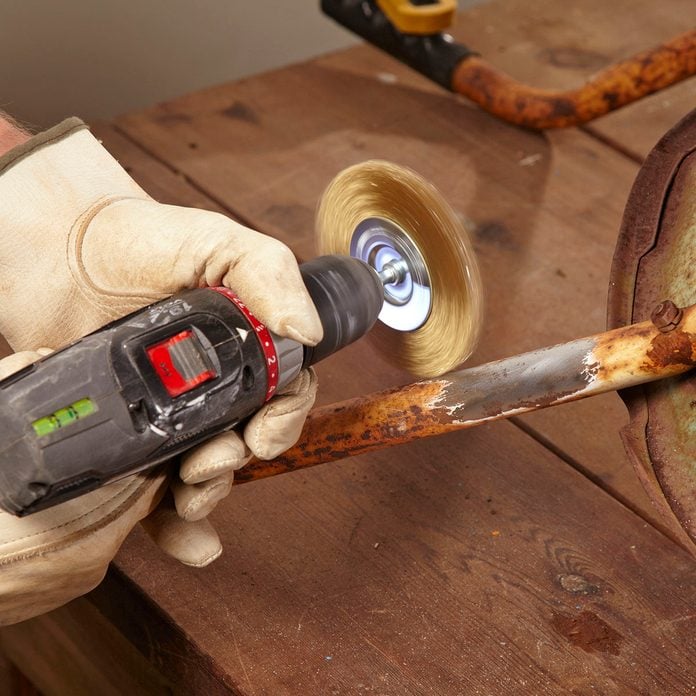
Step 2
Friction match the Abrasive to the Shape
- Utilize flap discs, fiber discs and sanders on large, flat areas.
- Switch to wire wheels for seams, corners and rounded rusted metal areas.
- Note: A broad range of stripping, grinding and sanding attachments are bachelor for grinders.
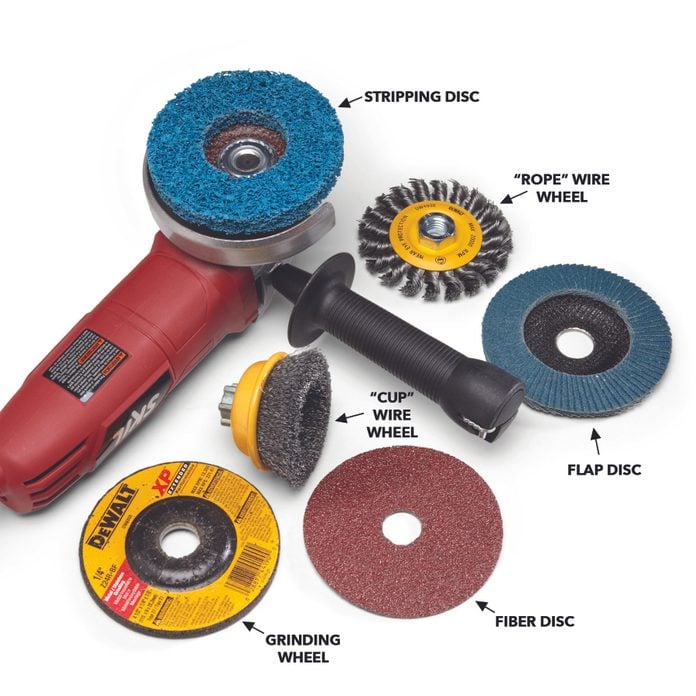
Pace 3
Detail Sander
- Use a detail sander for rusted metal corners, tight spots and small details.
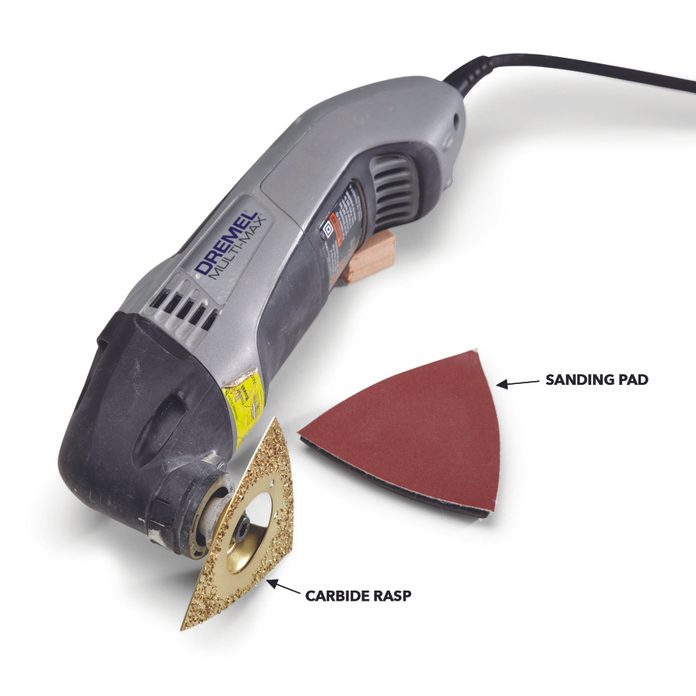
Pace iv
Drill Accessories
- Drill-mounted wire wheels and stripping discs tin can be used equally a rust remover instead of or in add-on to grinders, though they don't have equally much power or cover every bit much surface area.
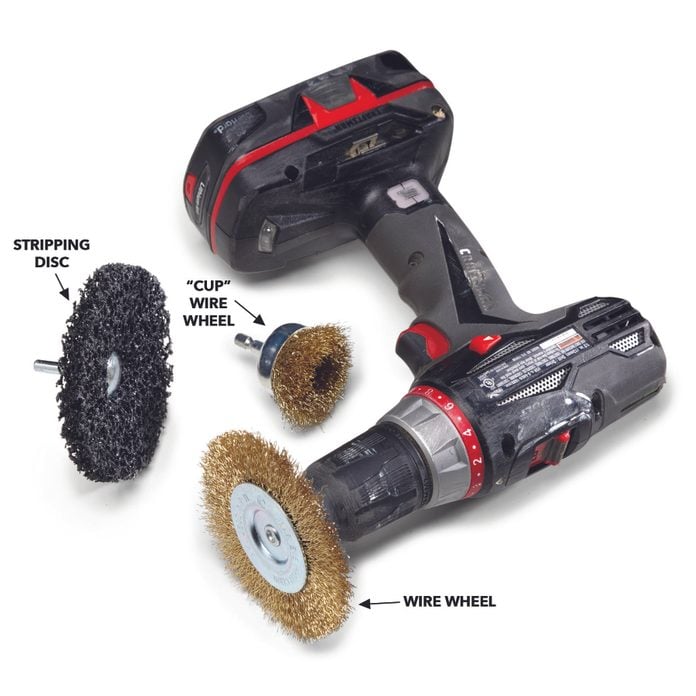
Step five
Power Sanders
- Finishing and random-orbit sanders are too useful tools for rust removal on flatter surfaces.
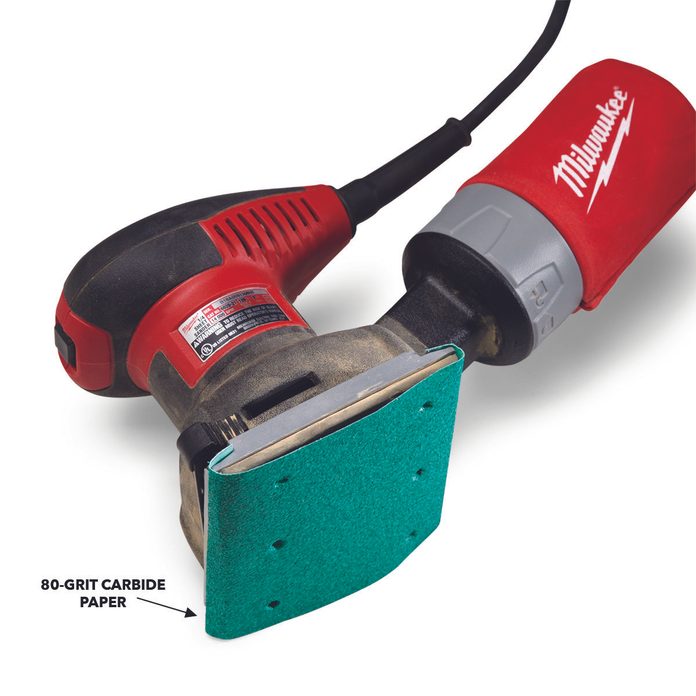
Step 6
The Chemical Removal Method
The former standby rust remover chemicals contain either phosphoric or hydrochloric acid to deliquesce the rust. They're harsh chemicals that give off some pretty intense fumes, so suit up with rubber gloves, goggles and a respirator. Find them in the paint department at any home eye. You'll besides need an old paintbrush, a waste product tub, a 3-inch putty pocketknife and rags.
- Apply the chemicals with the paintbrush and wait the recommended time for the chemicals to piece of work.
- Scrape off the liquefied rust.
- Note: Y'all won't get it all in a single pace—count on multiple applications to completely remove heavy rust buildup. Consider a gel formula when removing rust on vertical surfaces. Information technology'll cling amend and result in less runoff.
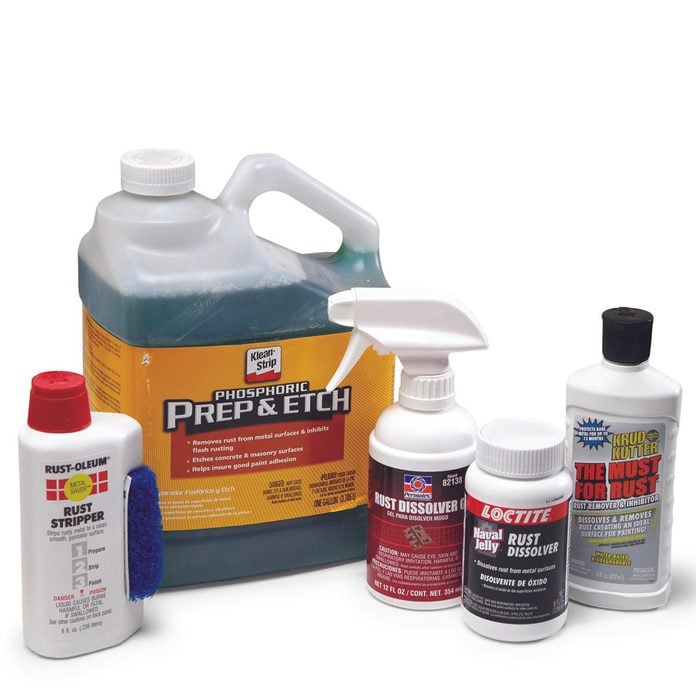
Step vii
Or Try Safer and Gentler Chemicals
-
- Note: Attempt one of the newer non-toxic and acrid-complimentary soaking solutions. These chemicals dissolve rust more than slowly, simply if y'all're patient, they work.
- Pour the rust remover solution in a plastic tub.
- Clean off whatever oil or grease on rusted metal before soaking.
- So drop in the rusted item and walk away.
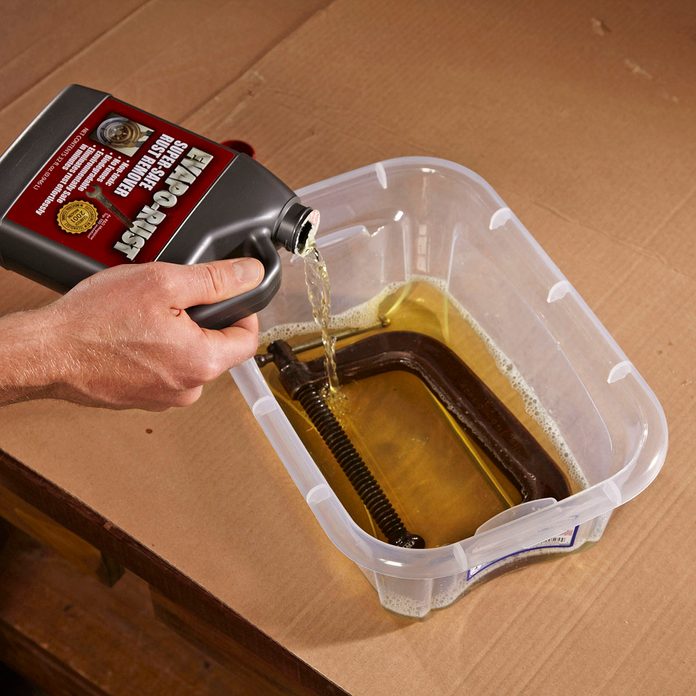
Pace 8
The Easiest Method to Combat Rust? Catechumen It.
If you tin can live with the look of a rough or pockmarked finish, rust converter tin can save you a lot of fourth dimension. It kills the rust, prevents its spread and dries into a gear up-to-paint primer. Buy information technology at whatever dwelling house eye or auto parts store.
- Outset by removing whatsoever flaking pigment and rusty dust with a wire brush.
- Either spray on the converter or apply it with a disposable paintbrush.
- Let it dry out for the recommended time.
- Pro tip: Even though the label says y'all can paint after it dries into a primer coat, I recommend spraying on a real primer, then painting.
- Utilise a second glaze of converter if you're not going to paint.
- Pro tip: Don't return the leftover converter to the bottle—it volition contaminate the rest. Toss it in the trash, forth with the brush.
Step nine
Choose Between Liquid and Spray Converter
- Rust converter comes in brushable liquid or aerosol spray.
- Rust remover spray provides a smoother finish but doesn't penetrate severe rust as well as brushable liquid.
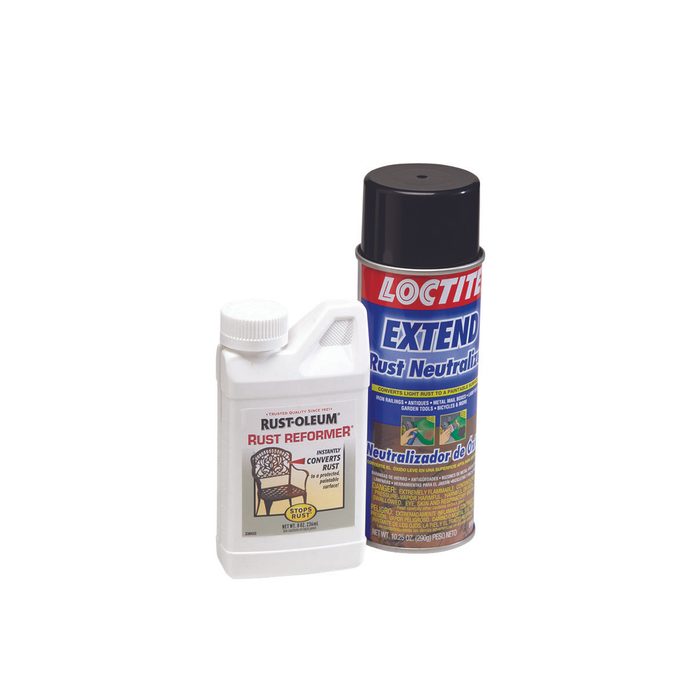
Step 10
Apply Converter Later Wire Brushing
- Pour a small amount of converter into a cup and work it into the rusty patches with a paintbrush.
- And then smooth out the brushstrokes and allow information technology dry out.
- When dry, the surface will look rough only rust-free.
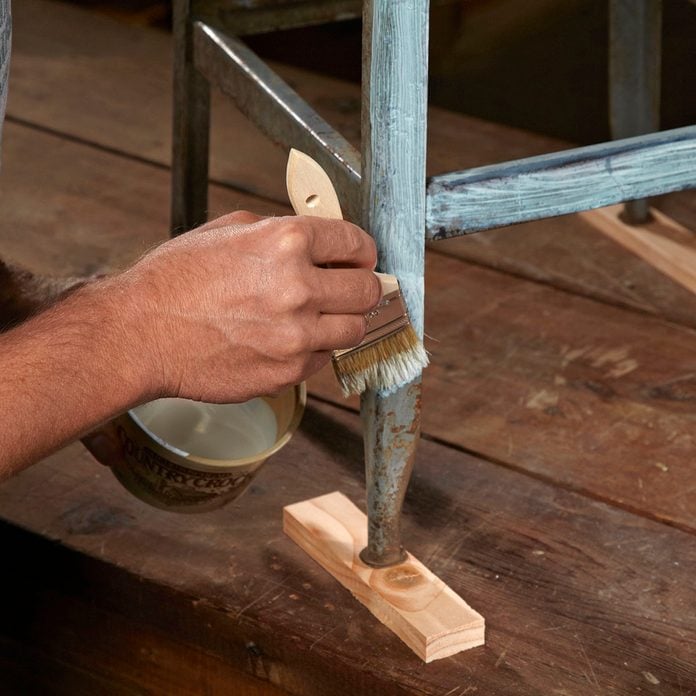
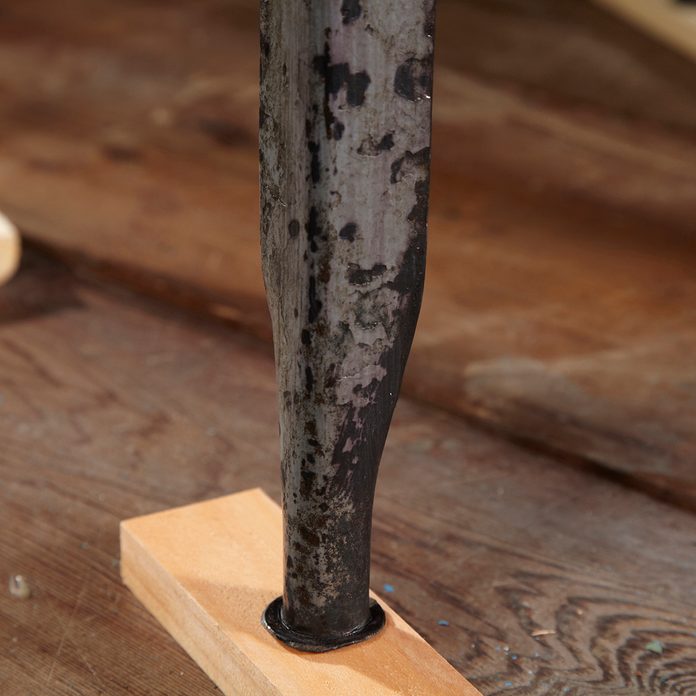
3 Ways to Remove Rust from Tools
Grind, sand or scour off the rust
Pros: No pockmarks and a smooth finish prior to painting. Complete project in a day. No waiting for chemicals to work.
Cons: Dirty, dusty, hard work. Requires power tools and lots of elbow grease.
Catechumen the rust
Pros: Easiest way to stop rust and prime in one operation. Less expensive than chemical or mechanical methods for removing rust.
Cons: Leaves a crude or pockmarked terminate that'll show after you lot paint. May not inhibit rust as long as traditional removal, priming and painting.
Remove rust with chemicals
Pros: Soaking removers can do all the piece of work for yous if the item is small enough. Spray removers profoundly reduce the grunt work, simply they require several applications and some scraping.
Cons: Long expect times for the liquid removers to exercise their job. Makes a huge mess. Soaking removers are expensive and tin be used only on minor items. The surface volition still exist pockmarked after the rust is gone.
Tip: Don't think you can spray rust-inhibiting paint onto a rusty surface and become good results. The rust will bleed right through the pigment and ruin your new pigment chore. Y'all have to deal with the rust with one of the methods nosotros evidence here. In that location's simply no mode around it.
Stride 11
Prevent Rust: Prime number Get-go
- Choose a regular (non-sandable) primer if the surface is completely smooth.
- To fill in scratches, choose a sandable primer and lightly sand when dry out.
- Utilise a filler primer to fill up in pockmarks.
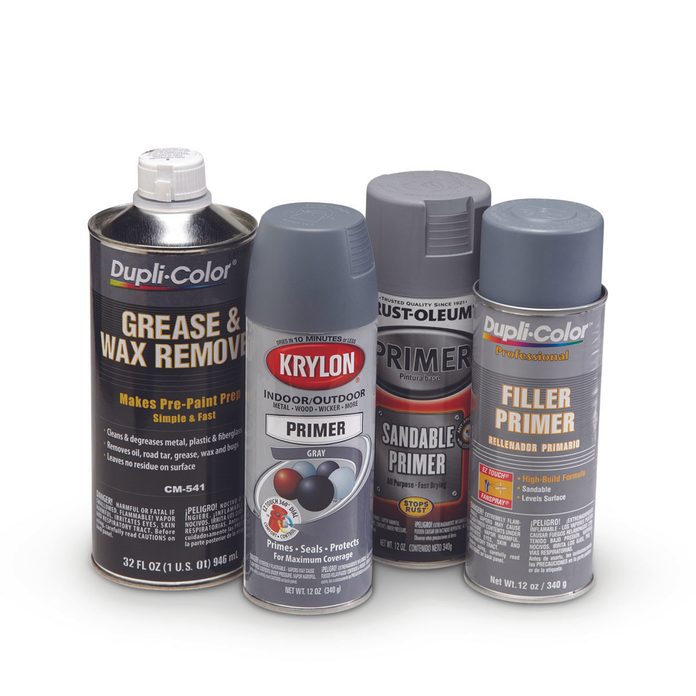
Step 12
Prepare and Prime
- Clean the metal before priming.
- Utilize the primer over the old paint and the newly sanded metal.
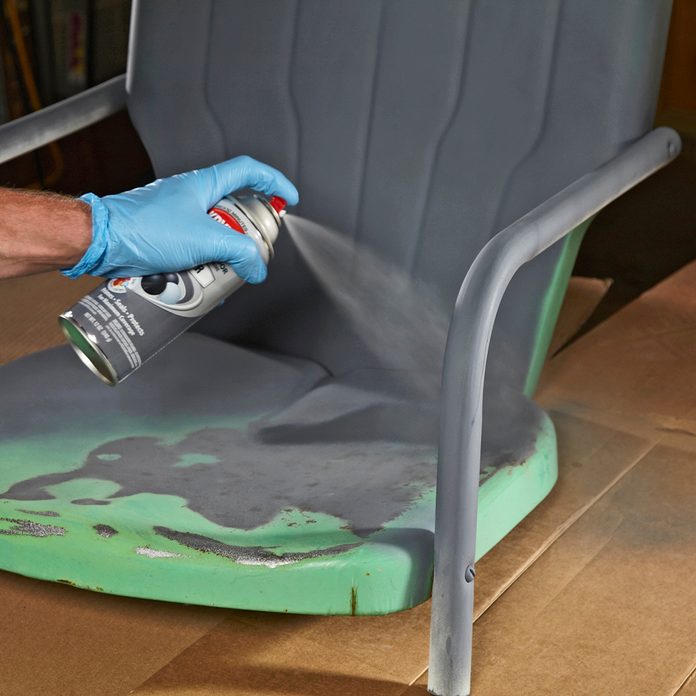
Step 13
Prevent Rust with Paint and Topcoat
-
- Note: Several companies make rust-inhibiting paint. If you don't find the color you like, attempt the pigment department at an auto parts store.
- Spray on a final topcoat of clear gloss.

Stride xiv
Employ a Articulate Topcoat
- Allow the colour coat to dry completely.
- Spray on a clear topcoat to extend the life of the pigment.

Pick a Loftier-Quality Paint
Afterwards all the nasty prep work, why risk another tour of rust by using cheap paint? Inexpensive pigment contains less paint, fewer resin binders and no rust inhibitors. Spend a few extra bucks on a premium rust-inhibiting paint. Information technology will contain zinc additives that provide an actress measure of protection against hereafter rust.
Brushing ordinarily provides a ameliorate pigment bond than spraying, only it leaves brushstrokes in the finish. Still, spraying is tricky and if you stay in 1 spot too long, you lot can air current up with paint sag marks in the end.
Whichever painting method you choose, seal the newly painted particular with a clear topcoat. That'll add to the gloss and dramatically increase the life of the paint by reducing paint oxidation.
Originally Published: December 30, 2020
Source: https://www.familyhandyman.com/project/how-to-remove-rust/
Posted by: autreysuccans.blogspot.com

0 Response to "How To Remove Surface Rust From Painted Signs"
Post a Comment